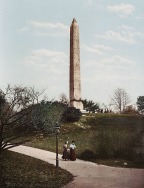History in the News:
Cleopatra’s Needle, New Human Cousins and Bog Bodies

Cleopatra’s Needle, 1901
One of the delights of living in NYC is Central Park. It’s not only a green space and refuge for weary urbanites, it’s the site of many monuments; some are gifts from other countries. One of the most magnificent is the 3,500-year-old granite obelisk commemorating King Thutmose III, commonly known as Cleopatra’s Needle, situated on a rise in back of the Metropolitan Museum of Art. This ancient artifact is one of a pair originally situated in Heliopolis, Egypt. The Romans moved them in 12 B.C. to adorn a temple in Alexandria. In 1877, the Khedive of Egypt gave one of the obelisks to the US. It was erected in Central Park in 1881 after an epic two and half year journey. It has sat in the New York climate ever since. Zahi Hawass, the secretary general of Egypt’s Supreme Council of Antiquities, recently posted on his blog a letter he sent to the Central Park Conservancy and Mayor Bloomberg, complaining about lack of proper care for the monument. He said, “I will take the necessary steps to bring this precious artifact home and save it from ruin.” The hieroglyphics are significantly eroded and many people believe the weathering occurred during the last century. The Conservancy denies that the monument has been neglected. This blog post uses photos to show the obelisk was already in poor shape when it arrived. Dr. Hawass is probably in error about when the erosion happened, but his complaint may spur the city and the Conservancy to make sure it doesn’t deteriorate further. I’ll update this post if the controversy continues. (Link to original article.)
Speaking of Dr. Hawass, he has some more bad news for tourists: King Tut’s tomb and two others will close by the end of the year. Ever since Howard Carter opened the tomb in 1922, the beautiful 3,300 year-old paintings adorning the rock walls started to deteriorate. Over a thousand visitors trek through the tomb each day bringing humidity, dust, and fungi which has irreparably damaged the art. Dr. Hawass has promised a replica will be built for visitors. Other heritage sites such as the Lascaux painted caves have had to resort to similar actions to preserve our priceless heritage. I would love to see the real thing, but not at the price of destroying the original. (Link to original article.)
Rock art is big in the news this month. Scientists have come up with a way to date it that won’t destroy the original work. Rock art is notoriously difficult to date, because the standard practice of radiocarbon dating needs several grams of organic material. Using a highly sensitive dating method, called accelerator mass spectrometry, researchers need only .05 grams (about the weight of 50 specs of dust) to determine age. (Link to original article.) In a related story, researchers have discovered that 40,000 year-old rock art in Western Australia maintains its vivid colors because it is colonized by bacteria and fungi. This, of course, interferes with the dating process. (Link to original article.) And check out this video on rock art at Archaeology.org.
One of the most exciting stories from last year was the discovery of remains of another human cousin in a cave called Denisova in southern Siberia. Researchers at the Max Planck Institute for Evolutionary Anthroplogy in Leipzig sequenced DNA from a tooth and showed the Denisovans were more closely related to Neanderthals than modern humans. (Link to original article.) They sequenced Neanderthal DNA earlier in the year showing that Neanderthals and our ancestors interbred. About 1 to 4 percent of non-African DNA is from Neanderthals. (Link to original article.) This year, geneticists at the Australian Centre for Ancient DNA (ACAD) at the University of Adelaide hope to recover DNA from a roughly 18,000-year-old H. floresiensis tooth, which was excavated in 2009 from the Liang Bua site on the Indonesian island of Flores. Soon we should know if we’re also related to the “Hobbits.” (Link to original article.)
Bog bodies (bodies found mummified in cold water swamps) have fascinated me since I saw one in the British Museum. The tanned leather consistency of the skin, the preserved fabric of the clothes, the list of his stomach contents preserved on a placard; I wanted to know the history of this man. Who was he? Husband, father, son? Slave, sacrifice, criminal? I made up a history for him in a short story called “Samhain,” but the facts eluded me. Bog bodies have also fascinated historians and archeologists. They’ve been found from Ireland to Russia; over 560 in Denmark alone. Archaeologist Moten Ravn of Denmark’s Viking Ship Museum in Roskilde proposed a survey of the bodies. Maybe I’ll get answers some of my questions. (Link to original article.)
To round out this month’s “History in the News,” here are several interesting, but miscellaneous stories:
- Rocker Boy George returned an icon looted from a church in Nicosia, Cyprus. He bought it in 1985. Church officials noticed the artifact during a TV interview and got in touch. Boy George gave it back immediately saying “I’ve always been a friend of Cyprus.”
- Italian police claim to have discovered Caligula’s tomb on Lake Nemi when they busted a looter with a statue recovered from the site. Classist Mary Beard of Cambridge and The London Times calls foul and disputes the Italian’s claim.
- Climate change is linked to the fall of the Roman Empire in this article.
- A recent find of four mosaics in Antioch provide clues to plays written by the popular ancient playwright Menander.
- Scientists have come up with new ways to date ceramics and catalog artifacts.
- The body of a Roman man, believed to be a gladiator, was discovered in York, England. He met a violent end and was “thrown out with the rubbish.” Here’s an interesting slide show called “Time of the Gladiators” on the Discovery Channel.
And finally, a couple of follow-ups on Italy’s woes and Turkey’s troubles:
- Here’s an article on the sad state of Pompeii and another on Italy’s attempt to raise funds for antiquities conservation through a hotel tax on tourists.
- Turkey followed through on its threat to bury a Roman city under sand in preparation for flooding it with a dam. Here are National Geographic pictures from Allianoi before it was buried.

Thanks for a nice blog! Since you cited a post of mine, I thought I would just clarify: Cleopatra’s Needle hasn’t weathered much over the last century. Most of the weathering took place when the obelisk was in Egypt, the causes of which are still unclear. Per Storemyr (www.per-storemyr.net)
Thanks for the clarification! That makes a big difference in how the story is perceived, particularly Dr. Hawass’ accusations of neglect. I’ll update the post to reflect that information.